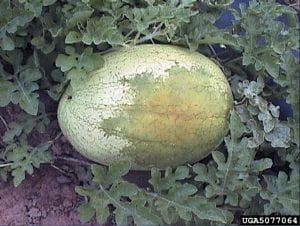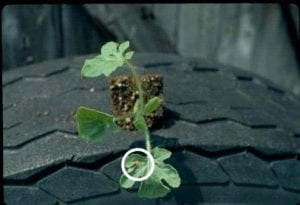Kate Everts, Vegetable Pathologist, University of Delaware and University of Maryland; keverts@umd.edu
I just received word from Dr. David Langston in Georgia that bacterial fruit blotch (BFB) was confirmed on seedlings destined for shipment to other watermelon producing areas. Some plants may have been shipped before the outbreak was identified. At this time we do not know if any seedlings were shipped to Maryland or Delaware. However, increased scouting of transplants is warranted. Because BFB is seed-transmitted, locally grown transplants should also be examined.
BFB of watermelon is caused by the bacterium Acidovorax avenae subsp. citrulli. The disease is damaging because it causes large olive green to brown water-soaked lesions on fruit (Figure 1), making them unmarketable. Symptoms of BFB on seedlings are water-soaked areas of the lower surface of the cotyledons and inconspicuous lesions on leaves (Figure 2). BFB lesions will become necrotic often with yellow halos. Lesions are frequently delimited by veins. Infected seedlings collapse and die.
Conditions in greenhouse transplant houses are highly favorable for the development of BFB symptoms and the spread of disease. If BFB is suspected, please send plants to a diagnostic lab (University of Maryland or University of Delaware) for identification. In the meantime, destroy all trays with symptomatic plants. Remove adjoining trays to a separate – isolated – area for observation. Monitor these isolated seedlings daily and destroy trays where symptoms develop. After symptomatic plants and adjoining trays are discarded, spray the remaining trays with a labeled fungicide and continue applications until the plants are shipped or transplanted to the field.
Figure 1. Olive green water-soaked lesion on watermelon fruit. (Image courtesy David B. Langston, University of Georgia, Bugwood.org)
Figure 2. An inconspicuous lesion of bacterial fruit blotch on a watermelon transplant.


